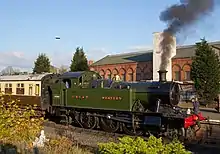GWR 4500 Class
The Great Western Railway (GWR) 4500 Class or Small Prairie is a class of 2-6-2T steam locomotives.
| GWR 4500 Class | |||||||||||||||||||||
|---|---|---|---|---|---|---|---|---|---|---|---|---|---|---|---|---|---|---|---|---|---|
 4569 at Dawlish | |||||||||||||||||||||
| |||||||||||||||||||||
| |||||||||||||||||||||
| |||||||||||||||||||||
| |||||||||||||||||||||
History
They were designed as small mixed traffic locomotives, mainly used on branch lines. The design was based on the earlier 4400 Class, but with larger driving wheels and altered wheel spacing. This gave them extra speed — capable of 60 mph (97 km/h) in service.[1] A total of 75 were built; 55 were built in four batches between 1906 and 1915 and a fifth batch of 20 locos was built in 1924, during Collett's tenure at Swindon. The first two batches were originally numbered 2161–2190 but were renumbered 4500–4529 during 1912. The first batch (2161–2180) is significant in that it was the last batch of locos built at Stafford Road Works, Wolverhampton.[2] Of this batch 2168 (as 4507) was the last Wolverhampton-built loco to remain in service with BR, not being withdrawn until 1963. The final two batches built were nos. 4530-4554 in 1913-15 and nos. 4555-4574 in 1924.
The 4575 Class was a later development with larger side tanks.
Rhondda and Swansea Bay Railway and Port Talbot Railway
The Rhondda and Swansea Bay Railway (R&SBR) had been worked by the GWR since 1 July 1906, although it was not absorbed until 1 January 1922.[3][4][5] In April 1907, the GWR sent three new locomotives of the first batch, nos. 2165–7, to the R&SBR; these were given R&SBR numbers 31–33.[6] The Port Talbot Railway (PTR) was absorbed by the GWR in 1 January 1908, but its locomotive fleet remained separate until 1 January 1922.[7][4][8] In March 1909, R&SBR nos. 31 and 32 were transferred to the PTR, regaining their GWR numbers 2165 and 2166. These two were returned to the GWR in 1912, being renumbered 4504 and 4505 in December that year. No. 33 was not returned until January 1914, when it was renumbered 4506.[6][9]
Preservation
Three of the class still exist, two of them survivors from Woodham Brothers scrapyard in Barry, Vale of Glamorgan, South Wales. All of them have run in preservation.
4555
4555 was bought in working order from British Railways by Patrick Whitehouse and fellow Talyllyn Railway member Pat Garland, so has never had to be restored. Originally working on the Dart Valley Railway, she later moved to the Dartmouth Steam Railway. She returned to steam in 2020 after having been under a major overhaul since 2014.[10]Currently on a 3 year loan to the East Somerset Railway from March 2020.
4561
This locomotive left Woodham Brothers in September 1975. It is currently undergoing an extensive overhaul on the West Somerset Railway, having been out of service since 1998.[11]
4566
Currently stored out of service on the Severn Valley Railway awaiting an overhaul, this locomotive left Woodham Brothers in August 1970. It returned to service in late 2006 following an overhaul and after several years painted in Great Western green, was repainted into BR unlined black with the early crest for the first time in preservation. It was withdrawn from service in January 2017 following the expiry of her boiler certificate.[12] It is on display inside the Engine House at Highly until its turn to overhaul comes again.

References
- le Fleming 1962, pp. J46–J50.
- Holcroft 1957, p. 44.
- MacDermot 1931, p. 436.
- Allcock et al. 1951, p. 13.
- Davies et al. 1966, p. K248.
- le Fleming 1962, p. J48.
- MacDermot 1931, p. 443.
- Davies et al. 1966, p. K242.
- Davies et al. 1966, pp. K247, K252.
- "South Devon Railway | Locomotives | Gone but not forgotten | GWR 2-6-2T No 4555".
- "The Locomotives - WSRA". Archived from the original on 14 October 2013.
- "SVR - Meet the Loco". Archived from the original on 6 January 2014.
- Allcock, N.J.; Davies, F.K.; le Fleming, H.M.; Maskelyne, J.N.; Reed, P.J.T.; Tabor, F.J. (June 1951). White, D.E. (ed.). The Locomotives of the Great Western Railway, part one: Preliminary Survey. Kenilworth: RCTS. ISBN 0-901115-17-7. OCLC 650412984.
- Davies, F.K.; Firth, J.M.; Lucking, J.H.; Thomas, R.E.; Allcock, N.J.; Sterndale, A.C.; Barrie, D.S.M.; Reed, P.J.T.; Mountford, E.R. (April 1966). White, D.E. (ed.). The Locomotives of the Great Western Railway, part ten: Absorbed Engines, 1922-1947. RCTS. ISBN 0-901115-20-7.
- le Fleming, H.M. (February 1962). White, D.E. (ed.). The Locomotives of the Great Western Railway, part nine: Standard Two-Cylinder Classes. RCTS.CS1 maint: ref=harv (link)
- Holcroft, H. (1957). Great Western Locomotive Practice 1837–1947. London: Locomotive Publishing Company.CS1 maint: ref=harv (link)
- MacDermot, E.T. (1931). History of the Great Western Railway, vol. II: 1863-1921. Paddington: Great Western Railway. OCLC 55853736.
- Whitehurst, Brian (1973). Great Western Engines, Names, Numbers, Types and Classes (1940 to Preservation). Oxford, UK: Oxford Publishing Company. ISBN 978-0-9028-8821-0. OCLC 815661.
External links
| Wikimedia Commons has media related to GWR 4500 Class. |